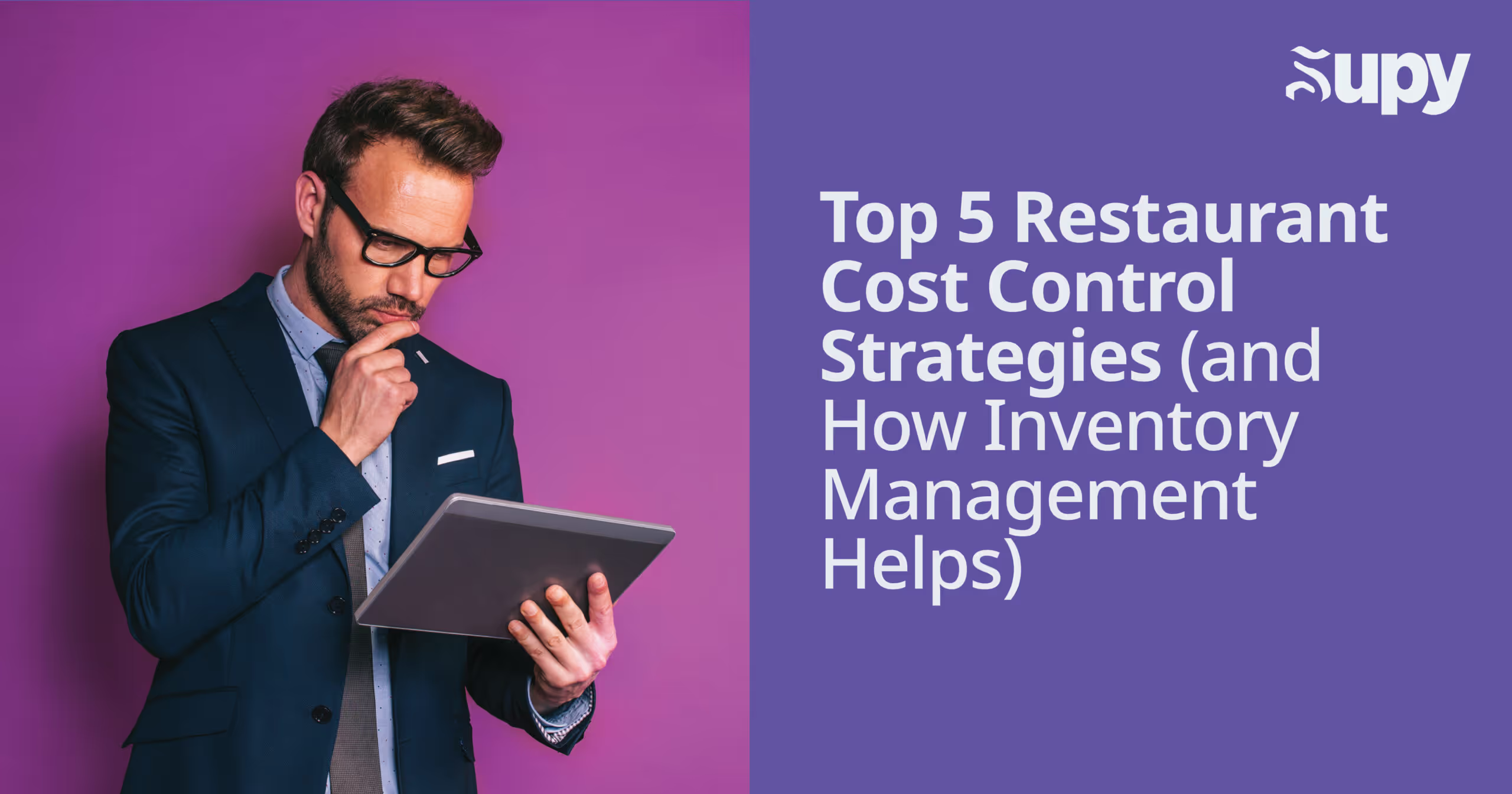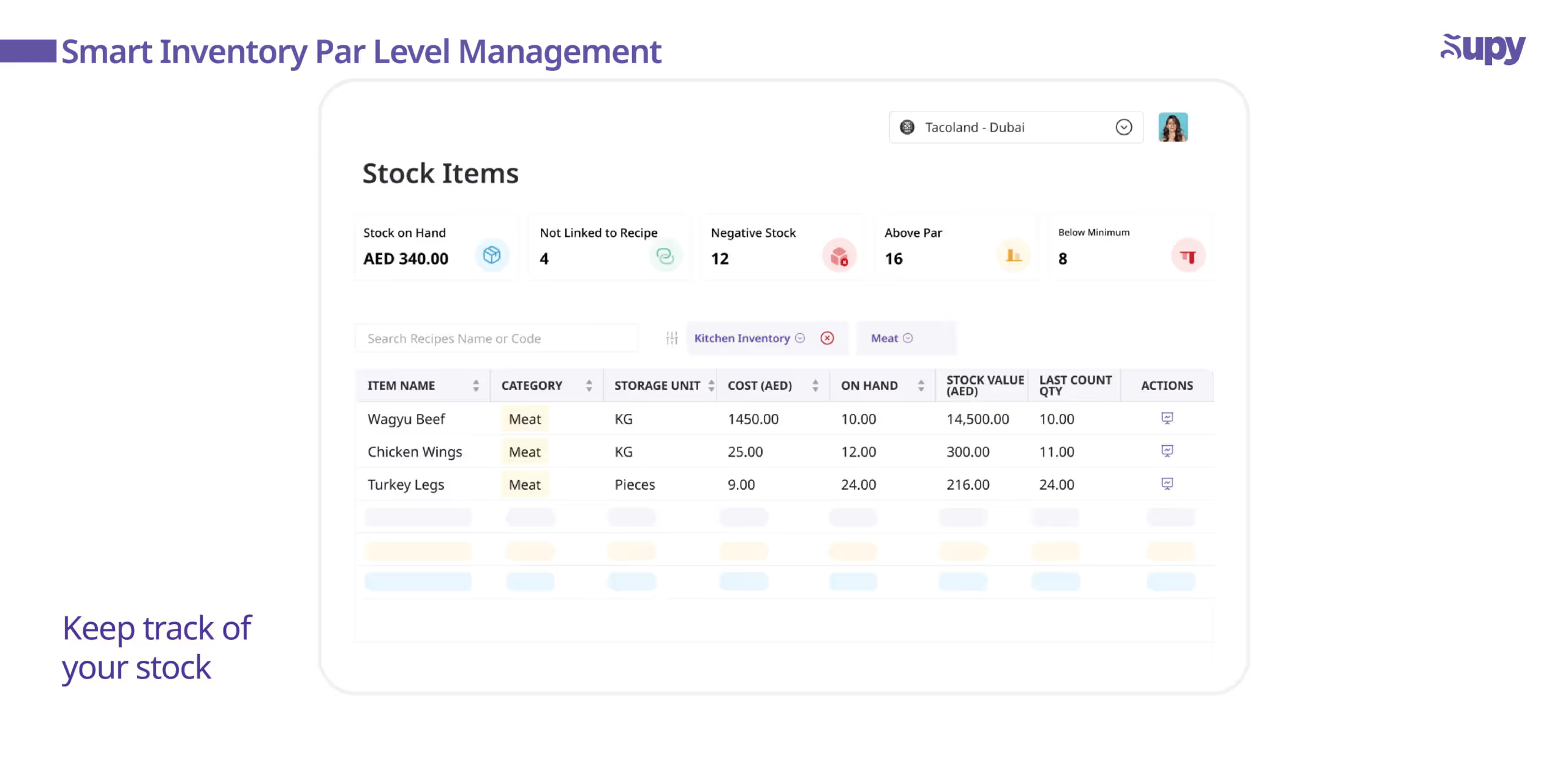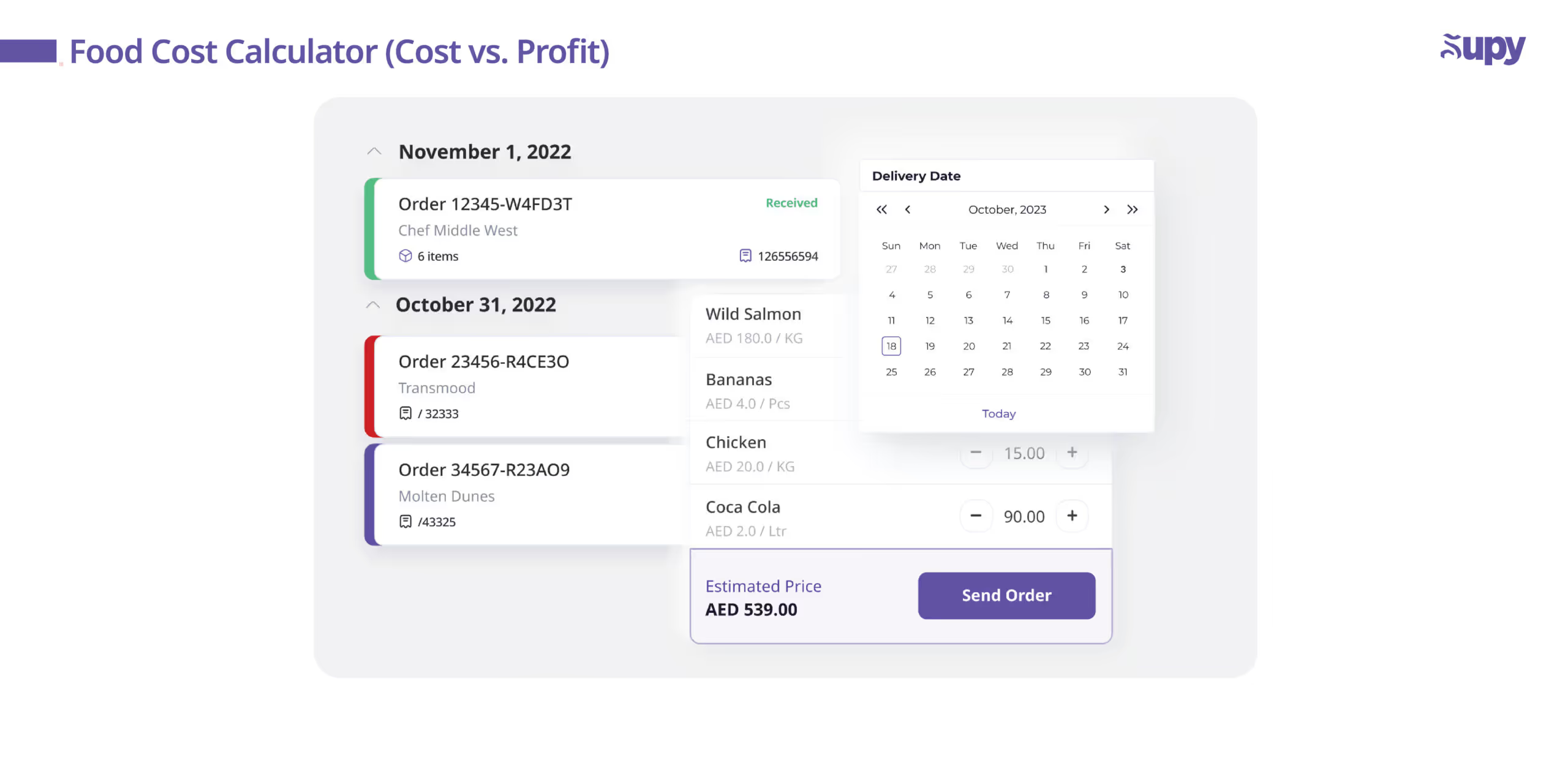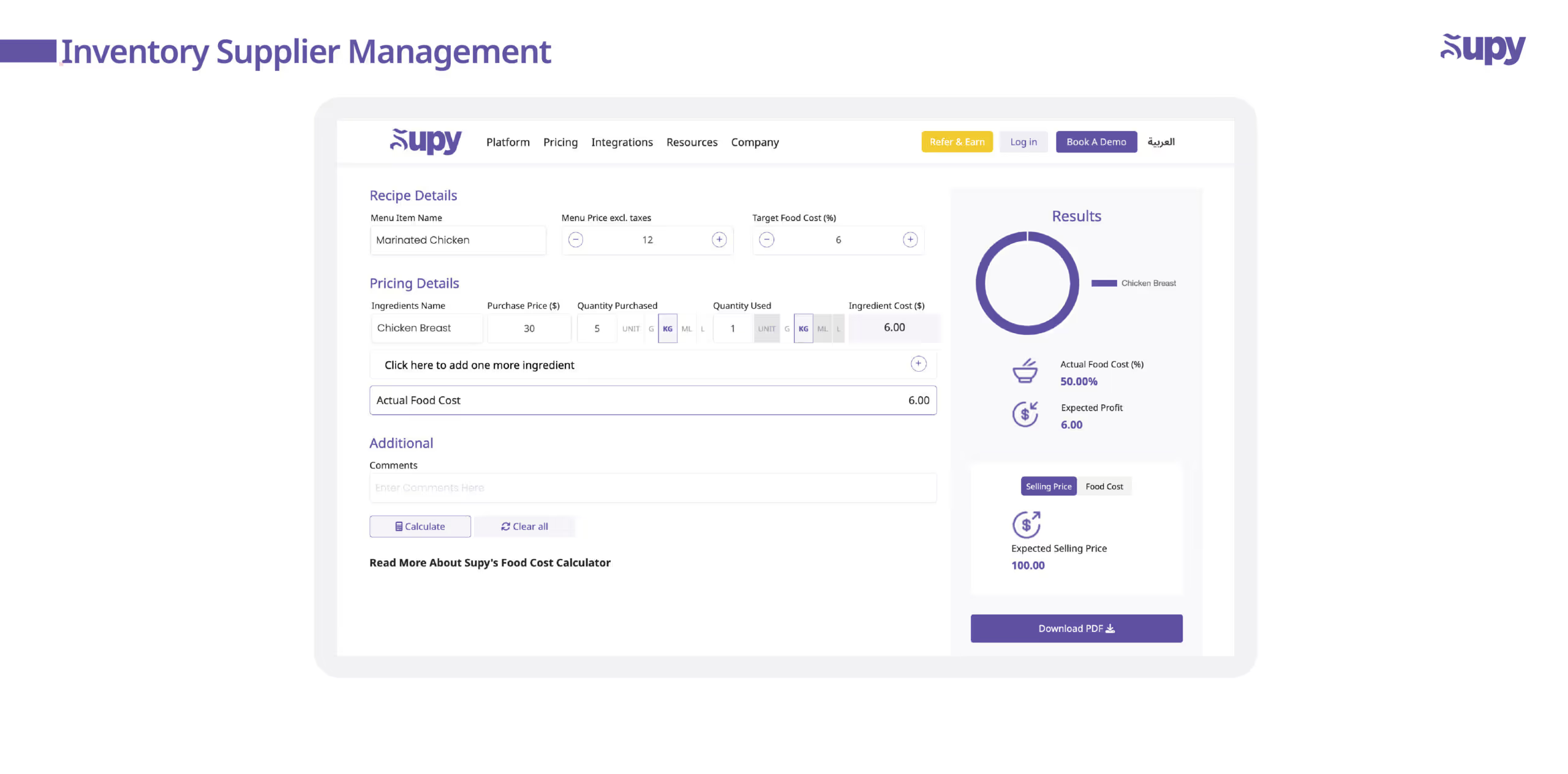Top 5 Restaurant Cost Control Strategies (and How Inventory Management Helps)

Running a restaurant business with rising food prices is tougher than ever. With already tight profit margins, every ingredient that gets more expensive puts more pressure on your bottom line.
According to the National Restaurant Association, wholesale food prices surged by 9.7% year-over-year in February. Some of the biggest spikes include:
- Chicken eggs: +183.3%
- Strawberries: +35.7%
- Coffee: +14.2%
- Potatoes: +23.0%
- Beef: +9.5%
When your core ingredients cost more, cutting expenses becomes non-negotiable. The right food cost control strategies help you reduce food waste, improve purchasing decisions, and keep your restaurant profitable, despite market fluctuations.
One of the most effective ways to do this? Inventory management software. It helps you track stock in real-time, prevent over-ordering, and avoid unnecessary losses.
Here are five strategies to control food costs and strengthen your restaurant’s financial performance:
- Strategy 1: Optimize Inventory Levels to Reduce Waste
- Strategy 2: Portion Control and Recipe Standardization
- Strategy 3: Audit Inventory Frequently to Prevent Losses
- Strategy 4: Smart Ordering and Supplier Management
- Strategy 5: Manage Labor and Prep with Inventory Forecasts
- Conclusion: Inventory as the Common Denominator
- About Supy
1. Strategy 1: Optimize Inventory Levels to Reduce Waste
One of the major reasons for rising food costs in your restaurant is the rising prices of ingredients. But are you maintaining the right inventory level to keep up with these costs?
Over-ordering or letting items sit too long on the shelf can lead to wasted food and lost profits. It’s important to maintain a balance between having enough stock to meet demand and avoiding excess that ends up going to waste.
Set Par Levels to Keep Stock in Check
Par levels ensure you have the right amount of food supplies on hand, enough to meet demand without unnecessary excess. Each ingredient should have a minimum and maximum threshold to prevent overstocking or running out.

Par levels ensure you have the right amount of food supplies on hand, enough to meet demand without unnecessary excess. Each ingredient should have a minimum and maximum threshold to prevent overstocking or running out.
Infographic
If your restaurant uses 20 pounds of chicken daily and receives deliveries twice a week, your minimum par level might be 30 pounds (to cover unexpected demand), while your maximum par level might be 60 pounds (to prevent overstocking).
- Track usage trends: Analyze past sales to determine average daily and weekly ingredient use.
- Adjust for demand fluctuations: Increase stock for weekends or peak hours, but avoid overstocking on slower days.
- Set smart reorder points: Automate restocking when inventory drops to the minimum threshold.
- Review regularly: Update par levels monthly to match shifts in demand and seasonal changes.
Track Inventory-to-Sales for Smarter Ordering
Besides par levels, it’s also important to analyze how much exactly your inventory is being . Tracking this gives you a clear picture of whether your food sales are matching your inventory, which will help you determine if you're effectively turning your stock into profits.
Two key metrics to help:
- Inventory-to-Sales Ratio – A high ratio means too much stock, which ties up cash and risks spoilage.
- Inventory Turnover Rate – A healthy rate (4-6) ensures steady ingredient use without overstocking.
Manually tracking stock is time-consuming and prone to errors. Supy automates inventory tracking, integrates with POS systems, and sends alerts for low stock and expiring ingredients, helping you make smarter purchasing decisions with minimal effort.
2. Strategy 2: Portion Control and Recipe Standardization
Inconsistent portions and oversized servings are a hidden drain on profits. Nearly 48% of consumers say excessive portions contribute to food waste, and 15% of main courses go uneaten. That’s wasted food and wasted money.
Monitor Portion Costs
Portion creep happens when serving sizes gradually increase without oversight. Over time, this can drive up actual food cost and eat into your margins. Without clear portion guidelines, your restaurant could be giving away thousands of dollars’ worth of extra ingredients every month.
Here’s how to reduce food costs by keeping portions under control:
- Use precise measurements: Weigh ingredients instead of estimating. Even small overages add up over time.
- Train staff to follow portion guidelines: Standardized serving sizes maintain consistency across all menu items.
- Monitor portion creep: Regularly check plated dishes to confirm they align with set portion sizes.
An inventory management system simplifies this by tracking how much of each ingredient should be used versus how much is actually being used.
Supy provides recipe cost analysis and variance reports, helping managers compare theoretical food costs to actual food costs. This makes it easier to spot inconsistencies and adjust portion sizes before they start affecting profits.

If you want a quick way to calculate food cost percentage, Supy’s free restaurant food cost calculator helps you analyze ingredient expenses and keep menu pricing profitable.
Standardize Your Recipes to Keep Costs in Check
Once you determine the best portion sizes for both customer satisfaction and profitability, the next step is to standardize them using a menu engineering approach. This is especially useful for multi-branch restaurants, where consistency means every customer gets the same experience.
Without standardized recipes, chefs may use different amounts of ingredients, leading to inconsistent portions and unpredictable costs. A recipe management system helps you:
- Maintain consistent taste and quality across all locations.
- Prevent ingredient overuse by setting exact measurements.
- Track dish profitability with precise cost calculations.
When portion control and recipe standardization are combined with inventory tracking, you gain full visibility into food cost percentage and can make data-driven adjustments to protect your margins.
3. Strategy 3: Audit Inventory Frequently to Prevent Losses
Many restaurant owners still rely on monthly stock counts, but by the time discrepancies are noticed, the damage is already done. Manual tracking, through Excel sheets or handwritten logs, is time-consuming and prone to mistakes.
With multiple staff members handling stock, errors in recording and tracking are inevitable. A 5% human error rate in restaurant inventory management means even small miscalculations can result in inventory costs climbing by hundreds or even thousands of dollars each month.
Conduct Weekly and Daily Inventory Checks
Switching to more frequent inventory audits helps catch discrepancies early, reducing the risk of unnoticed waste or theft. Here’s how to stay on top of food usage and prevent losses:
- Perform weekly cycle counts: Focus on high-cost or frequently used ingredients to ensure accuracy.
- Run daily spot checks: Monitor key stock items to catch discrepancies before they escalate.
- Rotate counting responsibilities: Assign different staff members to prevent errors and encourage accountability.
The most effective cost control measure is to automate stock tracking with an inventory management system. Supy’s automated tracking helps restaurant owners streamline audits, reduce shrinkage, and make smarter, data-driven purchasing decisions.
4. Strategy 4: Smart Ordering and Supplier Management
Many restaurant managers overlook how procurement and ordering processes contribute to higher food costs. Overbuying, inconsistent pricing, and unnecessary waste drive up expenses. Smarter ordering and real time supplier integration can lead to better savings.

Use Smart Ordering Techniques
Effective food cost management starts with understanding usage trends and purchasing patterns. With the right restaurant management system, you can track ingredient usage over time and make data-driven ordering decisions. This helps you:
- Avoid overbuying and reduce food waste
- Prevent stockouts that disrupt service
- Identify bulk order opportunities for supplier discounts
For example, if data shows you consistently use 200 pounds of chicken per week, ordering in bulk could save you 10-15% per unit. This reduces costs and minimizes the need for frequent reordering, cutting down order processing time.
Negotiate Better Pricing Through Supplier Management
Many restaurants miss cost-saving opportunities due to poor food supplier management. A restaurant management system integrates supplier catalogs, allowing real-time price comparisons to provide competitive pricing on every order.
Negotiating better pricing becomes easier with data-backed insights. Purchasing larger quantities consistently allows restaurants to secure bulk discounts, lowering costs by 5-10%.
Joining a group purchasing organization (GPO) can further reduce expenses by using collective buying power. GPOs provide access to supplier discounts that may not be available to individual restaurants.
5. Strategy 5: Manage Labor and Prep with Inventory Forecasts
Effective inventory forecasting doesn’t just save money on food, it can also optimize your labor costs. When you know exactly what ingredients are needed and when, you can prepare smarter to avoid over-prepping and wasting both food and labor hours.
Link Inventory Forecasts to Labor Efficiency
When inventory predictions are accurate, you can align your prep schedules with actual demand. Over-prepping often happens when there is a lack of clarity around inventory needs, leading to unused ingredients and wasted labor hours spent preparing food that isn’t needed. This excess prep not only costs more in ingredients but also ties up staff time in the kitchen, making labor costs inefficient.
With an inventory management software to forecast demand, you can:
- Predict ingredient usage based on sales trends and upcoming events.
- Optimize labor hours by matching prep work with actual inventory needs.
- Minimize waste to make sure food is only prepared when it’s needed, reducing both food spoilage and unnecessary labor.
Improve Prep Scheduling and Reduce Overhead
Inventory forecasts provide a clearer picture of how much prep work is needed. Analyzing past sales trends and menu requirements ensures that food is prepped in the right quantities, reducing time spent on unnecessary tasks.
For example, if a particular dish is consistently popular on Fridays but not on Tuesdays, prep schedules can be adjusted accordingly. This approach lowers labor costs without affecting quality or service.
Restaurants looking for creative and innovative ways to improve effective food cost control should use inventory forecasting to streamline operations. Smarter prep decisions mean fewer wasted ingredients, lower labor expenses, and a more efficient kitchen overall.
6. Conclusion: Inventory as the Common Denominator
Every strategy to manage food, labor, and supplier costs ties back to inventory. Without accurate tracking, restaurants face excess ordering, waste, and higher expenses, making profitability harder to sustain.
An inventory management system helps control stock, prevent overbuying, and align purchases with actual demand. Real-time tracking and automated alerts reduce waste, optimize ordering, and improve efficiency.
With tighter margins than ever, investing in the right software enables smarter decisions and long-term financial stability. Every percentage saved on food costs strengthens your bottom line.
For more insights, check out our eBook: The Ultimate Guide to Reducing Food Cost in Multi-Branch & Enterprise Restaurants.
7. About Supy
Supy is a smart inventory management solution built for the restaurant industry, helping businesses take control of their stock, reduce waste, and lower costs. Designed for multi-branch restaurants, it provides real-time tracking, automated stock replenishment, and data-driven insights to optimize purchasing and prep decisions.
See how Supy can help your restaurant minimize food waste and boost profitability. Book a demo today and take the first step toward smarter inventory management.







